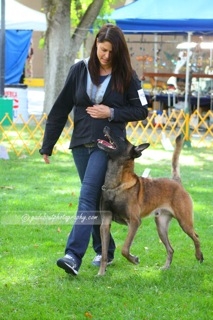Use Your Tools

Ah, it’s a lazy weekend morning and you’ve decided to take your pooch for a stroll to the local café to sit and sip and watch the world go by. You sit down at a sidewalk table and your peaceful morning plan is shattered because your dog is darting towards passersby of the canine sort and ruining what should be an idyllic moment just hanging out with your dog.
You start by reasoning with your dog, telling him to calm down, smiling through your embarrassment in an attempt to save face, show that it’s no big deal; your dog’s not dangerous after all. Then, as your frustration grows, your doggy-directed monologue changes tone, anger is creeping in and you start to get a little flustered. Perhaps you start repeating your dog’s name with indignation, “Bismarck! No, no, no!” You scold him as if he were a human toddler having a bit of a meltdown. Of course, none of the works, eventually you’ll abandon your agenda, get a to-go cup, collect your leash and march home, disheartened that your dog can’t just chill out and behave.
The funny thing is that the entire debacle could have been avoided if only you’d simply applied your basic training skills to this real-life situation. Your dog knows “sit”, right? And “watch”?
When we find ourselves in embarrassing social situations often our basic problem-solving skills seem to take a backseat to appeasement of the masses via inane chatter and reassurance. For some reason when this happens we tend to forget our skills. It may be a case of cognitive dissonance, we’re used to practicing our obedience skills in formal training sessions or in carefully crafted set-ups and have never quite made the leap to simply practicing on a regular basis, in everyday scenarios.
But I’m here to remind you to use your tools!
I’m not talking management devices or fancy, new-fangled equipment, I’m talking about your mad training skills.
A recent blog post by Kelli Danielson of Pride and Pedigree points out that your nuts and bolts obedience skills are the foundation of good behavior in everyday interactions.
So, with that in mind here is the key to creating a well-trained dog that is a joy to take along with you anywhere:
The first step is to build foundation skills such as, “sit”, “down”, “stand”, “watch”, “heel”, and “come”. There are many more, but, taught solidly these basics will get you very far.
The second step is to use them! Use your training as a tool for communication and a template for good manners. When you don’t like what your dog is doing ask them to do something else more acceptable. It’s that simple.
The third step is to practice your obedience skills every day in all sorts of scenarios as you go through your daily routine so you don’t lose them.
One final note, socialization is important, but be careful not to create a social loon. The goal is to make your dog comfortable and confident in just about every setting they’ll encounter, not to teach them to think that every place they go is a doggy rave. Playtime in lieu of basic manners is not cool. Be sure to teach and insist upon a baseline of proper manners from the beginning, as well as incorporating many mini-training breaks into any kind of social situation. Also, be sure not to overwhelm your dog. Socialization done wrong, with too much pressure and not enough breaks can cause a sensitive dog to shut down or become anxious when faced with too much at once. Read your dog’s body language don’t overdo it. The goal is to create a confident calm canine, not a party animal or shrinking violet. Regardless of your dog’s social personality, basic obedience can help your dog navigate a situation by proactively giving him something clear and appropriate to do and get rewarded for doing it. Happy training!
Photo by the awesome GadAboutPhotography.com




